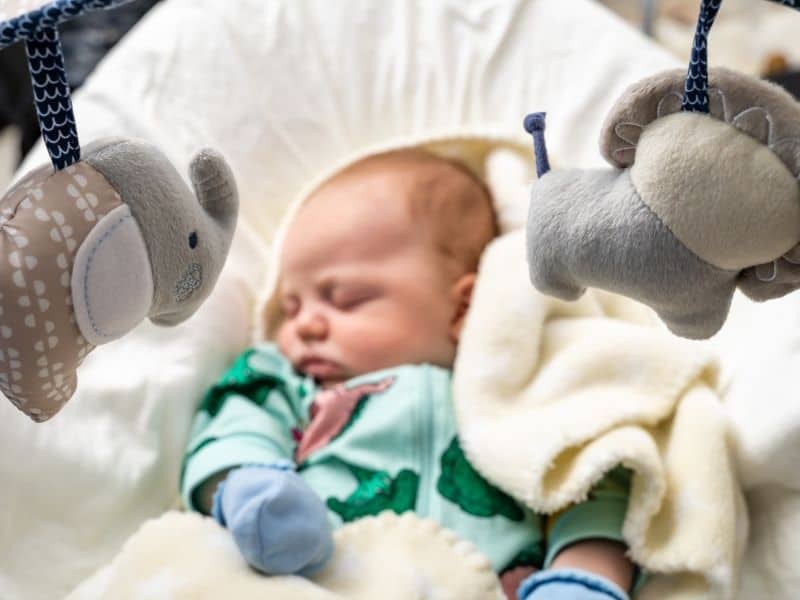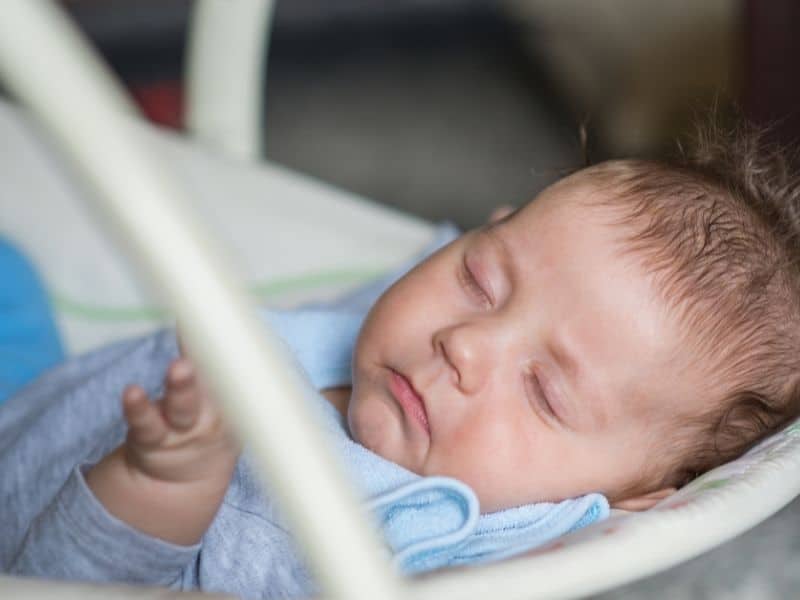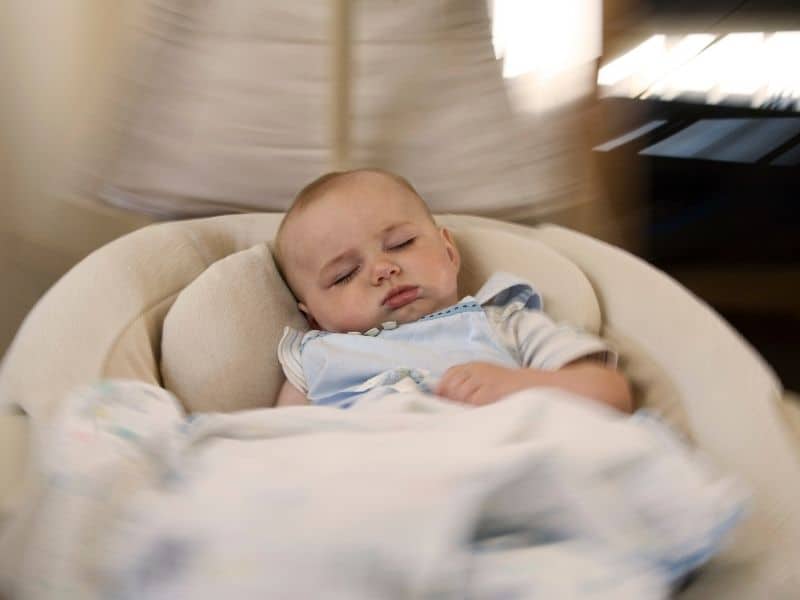There are three possible ways to answer the question – the short, the medium, and the long.

The short answer is, “Yes, a baby can swing too fast.” It’s theoretically possible for a swing speed to cause a baby harm in combination with other factors.
The ‘medium’ answer would be this – as long as you follow a few simple safety guidelines, baby swings ARE SAFE, and the speed is not likely to cause any damage. We’ll go into the guidelines below.
The long answer is this whole write-up – it’s a 5-minute read but can save you many a headache.
Stats about swing safety
I see the question from the title in my inbox at least once a month.
I always respond by quoting the same research – 35.1% of baby deaths in sitting devices occur in swings and bouncers.
If you’re thinking, “I just wanted to look into potential brain damage and the shaken baby syndrome,” don’t click away just yet.
THE ONLY responsible approach to baby swing safety is threefold:
- How it relates to Shaken Baby Syndrome (SBS) and potential brain damage
- How it relates to accidental deaths and SIDS
- How it relates to the baby’s age
If you’re unsure about the differences between a baby swing and bouncers, you can read more here – baby swing vs bouncer.
Are baby swings safe?
Yes, baby swings are safe as long as you:
- Follow a few simple rules
- You get a swing that meets the CPSC* requirements for baby products in North America.
I’ll take a moment to answer questions related to both. You can also read my detailed post on “Can baby sleep in a swing” where I go in-depth on the safety of baby swings.
Baby swings and Shaken Baby Syndrome
What is shaken baby syndrome?
Shaken Baby Syndrome is a specific brain injury type (swelling, bruising, bleeding) resulting from violent back and forth shaking of the baby.
Read more about baby swings, shaken baby syndrome and brain damage.
To put it simply – it’s a form of child abuse.
It happens because a baby’s head is relatively large compared to their body and their neck muscles are not strong enough to resist the shaking.
Three main reasons behind the injuries:
- Brain-to-skull contact
- Stress exerted on the tiny blood vessels because the gray and white matter in the brain travel at different velocities when shaken
- Swelling that causes further damage to the blood vessels
For simplicity reasons, I’ll refer to Shaken Baby Syndrome as SBS in the rest of the text.
How fast can you swing a newborn?
With newborns, limit both the intensity settings to low and the time spent in the swing to no more than one hour a day and 20-30 minutes at a time.
Think about what feels safe when the baby is in your arms (gentle swaying) and mimic that with the swing.

To read more on newborns and swings, go here – how long can a newborn be in a swing.
Should you adjust the swing speed to age?
As the baby grows, their neck muscles develop, you can gradually increase the intensity in consultation with your pediatrician. The pediatrician is the only person who can tell you what’s safe here because not every baby develops the same.
That’s why I cannot offer specific guidelines on adjusting the swing speed/intensity to age.
The AAP (American Academy of Pediatrics) recommends only using the most-reclined position for at least 4 months.
Can a standard baby swing setting be too fast for babies?
There’s no simple answer to that. It depends on the baby’s age, development, and a range of other factors.
In most cases, for a well-developed 5-month old it’s probably safe, but for a 2-month old preemie, you should probably keep the swing at the lowest setting in the most-reclined position.
When to stop using a swing?
Stop using the swing when your baby outgrows the recommended weight and size limit.
For more on that, follow this link – when to stop using a baby swing.
How swings relate to accidental deaths and SIDS
All potential dangers of a swing come from improper use.
Main risks – asphyxiation and strangulation
If you let your baby sleep in the swing, they might slouch because the head size is too much for the weak neck muscles. That’s an asphyxiation risk.
If you mess with the straps, it’s a strangulation risk. A closed chest buckle and open crotch buckle is an especially dangerous combo. In this scenario, the baby’s body might slide down, and their head might get caught in the chest buckle.
How to use a baby swing safely
To use a baby swing safely, follow these guidelines:
- A baby should only use a swing or a bouncer supervised.
- Don’t put your baby to sleep in a swing or in any other device that keeps them semi-upright (their head might fall to their chest because of the underdeveloped neck muscles)
- Swings should not be carried with the baby inside.
- Do not place the swing on an elevated surface, like a table.
- Up until four months of age, only use the most reclined position
- The straps should be snug but not tight to the point of interfering with the baby’s breathing.
- Do not unbuckle any straps.
- Additional toys and blankets are a no-no.
- Always follow the weight limits – they’re there for a reason.
Related reads: Can a baby sleep in swing
Sources: AAP news
Choosing a safe baby swing
Keeping your baby safe in a swing comes down to two things: choosing a good one and using it properly. We already covered the latter, but let’s take a moment here to cover the choice of a baby swing.

I have three main tips here.
1 – Stick with reputable brands
All the top swings from the top brands (like Fisher-Price, Graco, MamaRoo, Chicco, etc.) undergo strict certification and safety testing. Those safety aspects go beyond the ‘direct’ safety and into the manufacturing practices.
According to the Consumer Product Safety Improvement Act of 2008, baby swings must:
- Be painted with safe paint – no more than 90 ppm (parts per million of lead)
- Limit the use of lead in any parts accessible by the baby to 100 ppm
- Limit the use of specific chemicals in the plasticized components. For phthalates, the limit is 0.1%.
- Be tested by a lab that’s CPSC-certified.
- Be properly marked/labeled.
2 – Read the reviews
When considering a specific swing, take the time to read the reviews of existing owners.
3 – Lookout for recalls
So, can a baby swing too fast?
It is possible, but it’s not a real danger as long as you follow the guidelines outlined by the AAP and CPSC.
I tried to chew those down into bite-size pieces of information in the guide above. If it worked, you now understand the issue of swing safety better than 99% of parents.
Paul is a passionate dad who founded Upside Dad to share his parenting journey with other new parents. He graduated from Concordia University and worked as a test engineer for over a decade. Paul loves dad jokes and craft beer.
Learn more about Paul and Upside Dad here.
